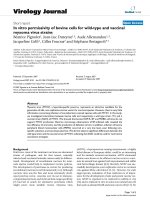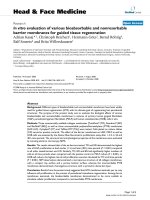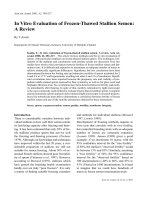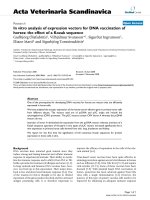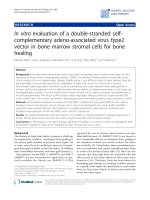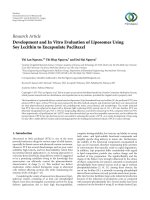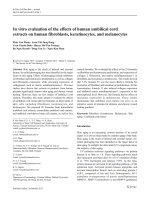In vitro evaluation of rice genotypes for brown plant hopper (Nilaparvata lugens Stal.) resistance
Bạn đang xem bản rút gọn của tài liệu. Xem và tải ngay bản đầy đủ của tài liệu tại đây (131.94 KB, 7 trang )
Int.J.Curr.Microbiol.App.Sci (2017) 6(3): 2547-2553
International Journal of Current Microbiology and Applied Sciences
ISSN: 2319-7706 Volume 6 Number 3 (2017) pp. 2547-2553
Journal homepage:
Original Research Article
/>
In vitro Evaluation of Rice Genotypes for
Brown Plant hopper (Nilaparvata lugens Stal.) Resistance
Archana Shori*, D.K. Rana, M.G. Sable and Poonam Kumari
Department of Entomology, Indira Gandhi Krishi Vishwavidyalaya,
College of Agriculture, Raipur- 492012, Chhattisgarh, India
*Corresponding author
ABSTRACT
Keywords
Rice, BPH,
Screening,
Nilaparvata lugens.
Article Info
Accepted:
20 February 2017
Available Online:
10 March 2017
A glass house experiment was conducted at Department of Entomology, IGKV, Raipur
(Chhattisgarh), during 2014-15 to evaluate different rice genotypes for brown planthopper
(BPH) resistance. A total of 392 rice genotypes were evaluated, of which 58 were from
IRRI, 78 were aromatic types and rest 256 represented the local germplasm. Of 58 rice
genotypes from International Rice Research Institute six viz. Ptb 33 (0.17), IR 03A159
(0.45), IR 09N522 (0.66), IR 07A179 (0.67), IR 08N136 (0.90) and IR 09N538 (0.91),
were found to be highly resistant to BPH while 32.7% were resistant. Among the 78
aromatic rice genotypes tested for BPH reaction, eight were identified as resistant viz. Lua
Nhe Den (1.66), Bong Cay (1.67), KDML 105 (1.94), UPR-2828-7-2-1 (2.39), IR 7542863 (2.56), Improved Pusa Basmati 1 (2.79), Shyamjeera (3.00) and Longku Labat (3.00),
while six as moderately resistant and rest as susceptible. In another set of experiment
conducted with 265 rice germplasm, only 11.32% exhibited resistance to BPH, lowest
plant damage score being recorded with 579004 (1.40), followed by 464205 (1.50) and
578983 (1.50) while 55 were moderately resistant and rest were susceptible.
Introduction
Rice (Oryza sativa L.) is a primary staple
food crop for billions of people worldwide.
India has the biggest area under rice
cultivation, as it is one of the principal food
crops. During the kharif marketing season
2012-13, Chhattisgarh recorded production of
over 7.12 MT of paddy worth Rs 11,000 crore
and was crowned as the rice bowl of India
(FAO 2013). However, production of this
crop is greatly hampered by several biotic and
abiotic factors. Among the biotic factors
brown planthopper (BPH), Nilaparvata
lugens (Stal.) (Homoptera: Delphacidae) is
consisted as one of the most important insect
pest in rice. It was first reported as a sporadic
pest of rice in 1927 around Tenali in Guntur
district
of
Andhra
Pradesh,
India
(Tirumalarao, 1950). Brown planthopper
infest the rice crop at all stages of plant
growth. The nymphs and adults of the insect
are usually found at the bases of the canopy,
where area is shady and humidity is high. As
a result of feeding by both nymphs and adults
at the base of the tillers, plants turn yellow
and dry up rapidly. At early infestation,
round, yellow patches appear, which soon
turn brownish due to the drying up of the
plants. The loss in grain yield due to this
insect range from 10% in moderately affected
fields to 70% in those severely affected. The
2547
Int.J.Curr.Microbiol.App.Sci (2017) 6(3): 2547-2553
damage to the standing crop sometimes
reached 100%. Farmers mostly depend on
chemical pesticides for the control of this
pest. Though insecticide application is
providing immediate control, ill effects like
resurgence, secondary out break and
development of resistance to insecticides are
most common with BPH. Hence, cultivation
of resistant rice varieties is the most
economical and efficient method for the
management of BPH (Renganayaki et al.,
2002).
For over 50 years, the development of host
plant resistance against these insect has been a
major focus at the International Rice Research
Institute (IRRI) and other national and
international rice research canters (Peng and
Khush, 2003; Brar et al., 2009; Jena and Kim,
2010). Standard seed box screening test has
been effectively used for screening resistant
lines (Heinrichs et al., 1985).
Chhattisgarh has relatively more virulent
population of BPH. The international material
which is being screened worldwide for BPH
resistance may have the good source of host
plant resistance against this pest. Hence the
study was conducted to know the reaction of
rice genotypes against Raipur BPH
population.
Materials and Methods
Fifty eight entries received from IRRI
(International Rice Research Institute) under
IRBPHN
(International
Rice
Brown
Planthopper Nursery), 78 (Seventy Eight)
aromatic rice genotypes provided by CANP
(Aromatic Network Project) under DBT
(Department of Biotechnology) and 265 rice
germplasm were used for this study. The
entries were evaluated by adopting
internationally accepted standard seed box
screening technique of IRRI. The rice
varieties Ptb 33 and TN 1 were taken as
resistant and susceptible check respectively.
Rearing of insect
Initially BPH population was collected from
the rice field. The collected insects were
reared and maintained in 45 days old host
plants in separate culture room which was
protected with wire mesh. The test and check
genotypes were pre-germinated in petri dishes
(10 cm diameter). Wooden box of standard
size (50x40x7 cm) was filled with fine wet
soil and levelled properly.
Each test entry was sown in single row
containing 20 pre-germinated seeds with a
spacing of 2 × 1cm including in middle
separate rows of resistant check PTB33 and
susceptible check TN1 were sown on borders
and in between the rows of test entries
respectively. After seven days of sowing, the
seedling were infested with second and third
instar nymphs of BPH at the rate of eight to
ten nymphs per seedling constitutes an
optimum population to differentiate the
resistant and susceptible lines. The final
damage rating was taken when the insect
killed more than 90 per cent of TN l
seedlings. The reactions were recorded on a
0-9 scale (IRRI - IRTP, 1975) as shown in
Table 1.
Results and Discussion
The indiscriminate use of chemical pesticides
with the aim to maximize crop productivity
has witnessed severe consequences to
environment. It not only leads to harmful
effect on soil micro and micro flora but also
greatly increases the chances of deleterious
effect of residual toxicity on human and
animal health. The demand for pesticide free
food urgently requires the alternatives to the
chemical pesticides. The use of resistant
genotypes presents one of the viable options
to this. With this aim the present work was
focussed to screen the rice genotypes resistant
to BPH. A total of 58 rice genotypes were
collected from International Rice Research
2548
Int.J.Curr.Microbiol.App.Sci (2017) 6(3): 2547-2553
Institute (IRRI) and screened for resistance to
BPH. It was observed that the IRRI has a
wide range of resistance sources for BPH
although rice genotypes exhibited varied
response to the Raipur BPH population. Table
2 enlists the average plant damage score of
rice genotype entries from IRRI (IRBPHN).
The results of 58 IRBPHN screening trials
showed that the rice genotypes viz. Ptb33
(0.17), IR 03A159 (0.45), IR 09N522 (0.66),
IR 07A179 (0.67), IR 08N136 (0.90) and IR
09N538 (0.91) were highly resistant. The
BPH resistance of genotype Ptb33 has already
been cited (Jairin et al., 2007).
The average plant damage score of 32.7% of
rice genotypes ranged from 1.00 to 3.00 and
were categorized as resistant ones. The
genotype IR 09A136 showed the least plant
damage score (1.00) followed by IR 06M144
(1.13) and IR 06M143 (1.18).
In comparison to IRRI rice genotypes,
aromatic rice and local genotypes were less
resistant to BPH. Of 78 aromatic genotypes
tested, only eight were categorized as
resistant, Lua Nhe Den recorded the lowest
plant damage score (1.66) followed by Bong
Cay (1.67) and KDML 105 (1.94) while six
were moderately resistant (Table 3).
Among 265 local rice germplasm tested,
thirty genotypes were categorized as resistant
while only 20.7% were moderately resistant.
The genotype 579004 surpassed others with
the lowest plant damage score (1.40) followed
by 464205, 578983 (1.50) (Table 4).
Table.1 Standard for rating damage by brown planthopper (IRRI-IRTP, 1975)
Grade of damage
Rating*
Symptom
0
HR
No visible damage
1
R
Partial yellowing at first leaf
3
MR
First and second leaves partially yellow
5
MS
Pronounced yellowing and some stunting
7
S
Wilting and severe stunting
9
HS
All test plants dead
*HR = highly resistant; R = resistant; MR = moderately resistant; MS = moderately susceptible;
S = susceptible; HS = highly susceptible
2549
Int.J.Curr.Microbiol.App.Sci (2017) 6(3): 2547-2553
Table.2 Average plant damage score of rice genotypes (IRBPHN)
against BPH, Nilaparvata lugens (Stal.)
S. No.
1
2
3
4
5
6
7
8
9
10
11
12
13
14
15
16
17
18
19
20
21
22
23
24
25
26
27
28
29
30
31
32
33
34
Designation
Ptb 33
IR 03A159
IR 09N522
IR 07A179
IR 08N136
IR 09N538
IR 09A136
IR 06M144
IR 06M143
IR 08N195
IR 06M150
IR 06N155
IR 04A115
IR 05N419
IR 10A110
IR 05N170
IR 06N234
TME80518
IR 10F203
IR 06N119
IR 10A155
IR 10F388
IR 09A152
IRRI 151
Pokkali
IR 10F336
IR 09A228
RP 4964-100-10-9-5-1-1
IR 09N142
IR 10N269
IR 10N304
IR 09F436
IR 13146-45-2-3
IR 09N500
*Average plant damage
score
0.17
0.45
0.66
0.67
0.90
0.91
1.00
1.13
1.18
1.36
1.47
1.64
1.69
1.89
1.89
1.93
2.05
2.08
2.25
2.32
2.38
2.61
2.63
2.67
3.00
3.01
3.22
3.24
3.28
3.39
3.95
4.38
4.54
4.97
* Average plant damage score based on 3 replications
2550
**Rating
HR
HR
HR
HR
HR
HR
R
R
R
R
R
R
R
R
R
R
R
R
R
R
R
R
R
R
R
MR
MR
MR
MR
MR
MR
MR
MR
MR
Int.J.Curr.Microbiol.App.Sci (2017) 6(3): 2547-2553
Table.3 Average plant damage score of aromatic rice genotypes against BPH,
Nilaparvata lugens (Stal.)
S.
No.
1
2
3
4
5
6
7
8
9
10
11
12
13
14
Accession
No.
CANP 421
CANP 406
CANP 121
CANP 521
CANP 535
CANP 309
CANP 168
CANP 422
CANP 496
CANP 510
CANP 410
CANP 339
CANP 412
CANP 549
Designation
Source
Lua Nhe Den
Bong Cay
KDML 105
UPR-2828-7-2-1
IR 75428-6-3
Improved Pusa Basmati 1
Shyamjeera
Longku Labat
JGL 1798
Kh.Sakani
Daw Leuang
Guinata
IET 18033 (RP 3644-9-5-3-2)
VIETNAM/DRR
VIETNAM/DRR
THAILAND/CBT
PANTNAGAR
IRRI/DRR
IARI/DRR
RPR
INDONESIA/DRR
JGL/DRR
DRR
THAILAND/DRR
PHILIPPINES/DRR
DRR
*Average
plant damage
score
1.66
1.67
1.94
2.39
2.56
2.79
3.00
3.00
3.11
3.24
3.25
3.33
3.67
4.86
**Rating
R
R
R
R
R
R
R
R
MR
MR
MR
MR
MR
MR
* Average plant damage score based on 3 replications
Table.4 Average plant damage score of rice germplasm against BPH, Nilaparvata lugens (Stal.)
S. No.
1
2
3
4
5
6
7
8
9
10
11
12
13
14
15
16
17
18
19
20
21
IC. No.
579004
464205
578983
578984
578969
578979
465043
578674
578149
577517
577293
578401
578972
578717
579011
577390
578443
578992
464884
577663
578417
*Average plant damage
score
1.40
1.50
1.50
1.70
1.80
1.80
1.90
2.00
2.10
2.30
2.40
2.40
2.40
2.50
2.50
2.60
2.60
2.60
2.70
2.80
2.80
2551
**Rating
R
R
R
R
R
R
R
R
R
R
R
R
R
R
R
R
R
R
R
R
R
Int.J.Curr.Microbiol.App.Sci (2017) 6(3): 2547-2553
22
23
24
25
26
27
28
29
30
31
32
33
34
35
36
37
38
39
40
41
42
43
44
45
46
47
48
49
50
51
52
53
54
55
56
57
58
59
60
61
62
63
64
65
66
466399
2.81
R
578017
2.90
R
578144
2.90
R
464129
3.00
R
578102
3.00
R
578128
3.00
R
578137
3.00
R
579022
3.00
R
578927
3.00
R
578721
3.10
MR
578406
3.11
MR
578957
3.11
MR
579010
3.12
MR
578527
3.13
MR
578329
3.18
MR
578131
3.22
MR
578135
3.22
MR
578358
3.22
MR
579035
3.25
MR
466603
3.26
MR
579030
3.31
MR
466609
3.40
MR
463306
3.50
MR
578413
3.50
MR
463854
3.55
MR
578967
3.55
MR
578139
3.58
MR
578737
3.60
MR
579034
3.60
MR
578459
3.63
MR
578965
3.66
MR
463905
3.72
MR
578680
3.78
MR
577478
3.80
MR
578148
3.88
MR
579036
3.90
MR
463018
4.00
MR
462531
4.00
MR
577788
4.00
MR
578500
4.00
MR
578914
4.00
MR
579012
4.00
MR
579013
4.00
MR
578444
4.05
MR
578371
4.16
MR
*Average plant damage score based on 3 replications
2552
Int.J.Curr.Microbiol.App.Sci (2017) 6(3): 2547-2553
Same kind of results was reported by Ali et
al. (2012) the donors like Mudgo, ASD7,
Raghu hematic, Babawee, ARC10550,
Swarnalatha, T12, Chin saba and Balamawee
showed no resistance to BPH. Most of the
genotypes which were proven as resistant to
BPH in earlier by different parts of the world,
were found to be susceptible in our screening
at Chhattisgarh, Bharat. Bhimrao et al.,
(2005) have screened 4324, 50423, 38,168,
and 121 entries, respectively and stated 20,
555, 5, 7 and 3 varieties under resistant
category. This study indicated that a major
portion of the tested rice genotypes are
resistant to the BPH population.
References
Ali, M.P., Alghamdi, S.S., Begum, M.A.,
Anwaruddin, A.B.M., Alam, M.Z. and
Huang, D.C. 2012. Screening of Rice
Genotypes for Resistance to the Brown
Planthopper, Nilaparvata lugens (Stal.).
Cereal
Research
Communications,
40(4):502-508.
Brar, D.S., Virk, P.S., Jena, K.K., and Khush,
G.S. 2009. Breeding for resistance
planthoppers in rice. In: Planthoppers:
New Threats to the Sustainability of
Intensive Rice Production Systems in
Asia, pp. 401-409. Heong, K. L. and
Hardy, B. Eds., International Rice
Research
Institute,
Los
Banos,
Philippines.
Bhimrao, K.G., Dubey, V.K. and Pophaly, D.J.
2005. Studies on relative degree of
damage
by
Brown
planthopper
Nilaparvata lugens (Stal.) on rice
genotype and its management through
plant derivatives. M.Sc. (Ag.) Thesis,
Indira Gandhi Krishi Vishwavidyalaya,
Raipur, p. 45.
Heinrichs, E.A., Medrana, F.G. and Rapusas, H.R.
1985. Genetic evaluation for insect
resistance in rice. Los Banos, Philippines,
International Rice Research Institute, p.
356.
IRRI-IRTP. 1975. International Rice Testing
Programme. Preliminary report of the first
international rice brown planthopper
nursery (IRBPHN). International Rice
Research institute, p.7.
Jairin, J., Phengrat, K., Teangdeerith, S.,
Vanavichit, A., and Toojinda, T. 2007.
Mapping of a broad-spectrum brown
planthopper resistance gene, Bph3, on
rice chromosome 6. Mol. Breeding,
19:35-44.
Jena, K.K. and Kim, S.M. 2010. Current status of
brown planthopper (BPH) resistance and
genetics. Rice, 3: 161-171.
Peng, S. and Khush, G. S. 2003. Four decades of
breeding for varietal improvement of
irrigated lowland rice in the International
Rice Research Institute. Plant Prod. Sci.,
6: 157-164.
Renganayaki, K., Fritz, A.K., Sadasivam, S.,
Pammi, S, Harrington, S.E., McCouch,
S.R., Kumar, S.M. and Reddy, A.S. 2002.
Mapping and progress toward map based
cloning of brown planthopper biotype4
resistance gene introgressed from Oryza
officinalis into cultivated rice, O. sativa.
Crop Science, 42: 2112-2117.
Tirumalarao, V. 1950. Nilaparvata lugens (Stal.)
(Fulgoridae : Homoptera) as a pest of
paddy cultivation in North Madras and its
control. Indian Journal Entomology,
12:241-246.
How to cite this article:
Archana Shori, D.K. Rana, M.G. Sable and Poonam Kumari. 2017. In vitro Evaluation of Rice
Genotypes for Brown Plant hopper (Nilaparvata lugens Stal.) Resistance.
Int.J.Curr.Microbiol.App.Sci. 6(3): 2547-2553. doi: />
2553
